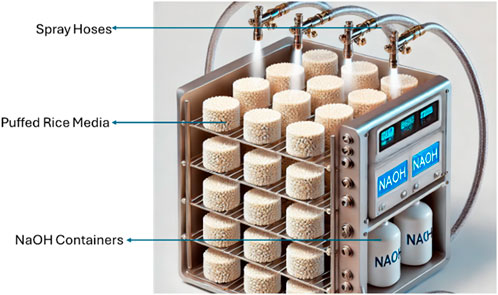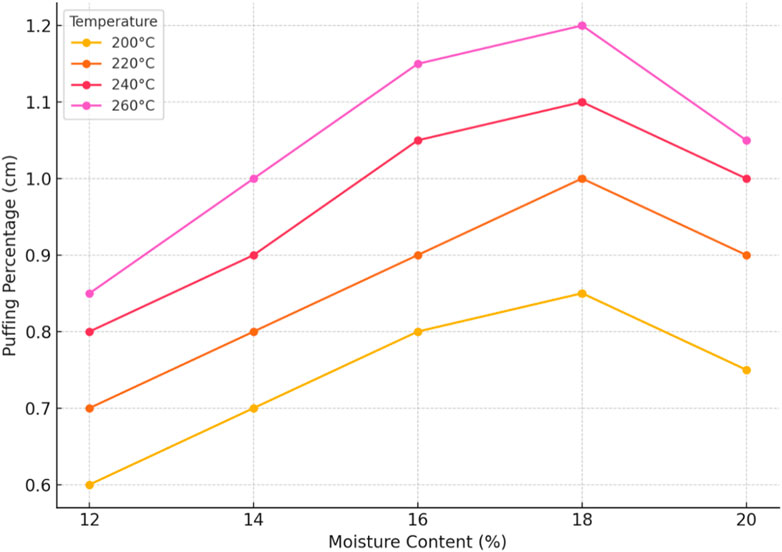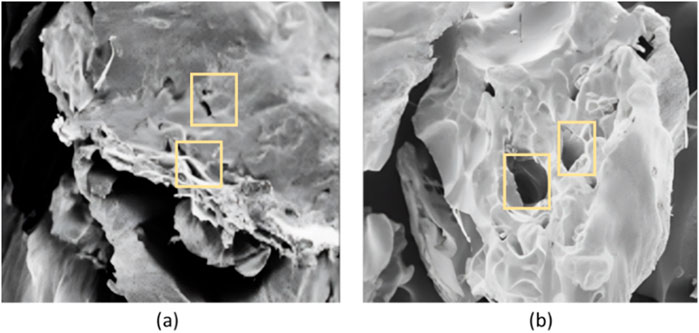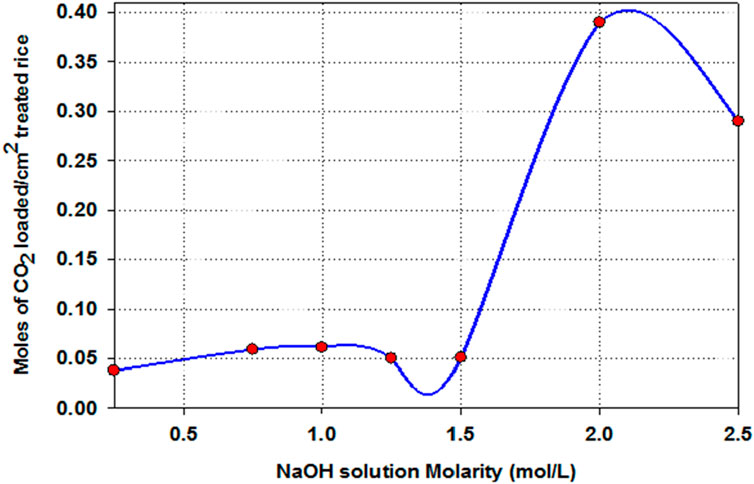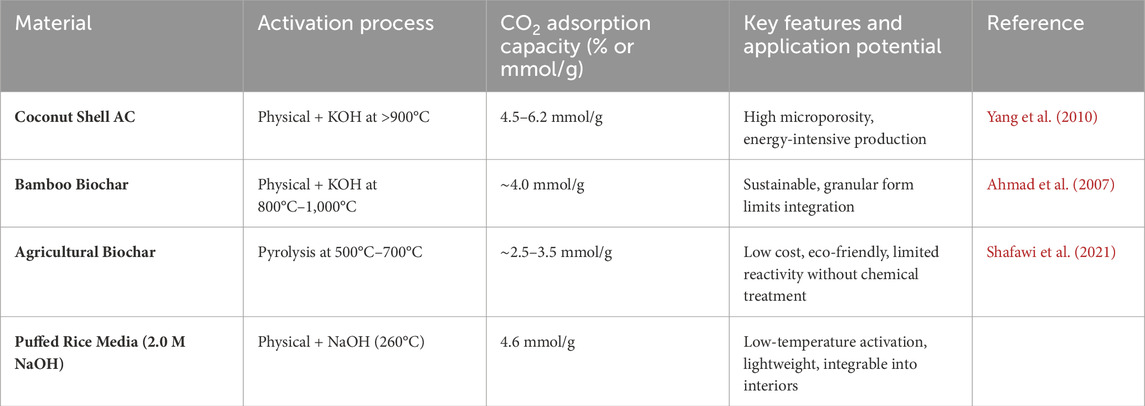- 1College of Engineering, UAE University, Al-Ain, United Arab Emirates
- 2King Saud University, Riyadh, Saudi Arabia
Introduction: The study addresses IAQ and rice waste management with a bio-based material for CO₂ capture.
Methods: Rice was thermally puffed and treated with NaOH. Characterization and performance evaluation were conducted.
Results: Achieved 38% CO₂ removal at 2 M NaOH treatment, with enhanced porosity confirmed.
Discussion: The material provides a sustainable IAQ solution, suitable for architectural integration.
1 Introduction
Indoor environments are complex ecosystems influenced by outdoor conditions, building design, and occupant activities. These factors contribute to the presence of various indoor pollutants, including chemical gases such as carbon monoxide (CO), carbon dioxide (CO2), ozone (O3), and volatile organic compounds (VOCs), as well as biological contaminants and particulate matter (PM) (Levin, 2003). Among these, CO2 has received increasing attention due to its adverse effects on human health and cognitive function at elevated concentrations (Mewomo et al., 2023). While strategies such as improved ventilation and the deployment of purification technologies have been widely studied, the growing emphasis on sustainable construction introduces additional challenges: the use of recycled or waste-based materials, although environmentally beneficial, can sometimes exacerbate IAQ issues (Choe et al., 2022).
The importance of IAQ is amplified by the fact that individuals spend up to 90% of their time indoors (Du et al., 2011). Poor IAQ is linked to a variety of health outcomes, from short-term symptoms like headaches and dizziness to long-term respiratory and cardiovascular diseases (Yang et al., 2004). Furthermore, insufficient ventilation and elevated indoor CO2 levels are contributing factors to Sick Building Syndrome (SBS), particularly in educational and occupational settings (Burge, 2004; López et al., 2023). Long-term exposure to CO2 concentrations exceeding typical indoor baselines (e.g., 1,000–2,000 ppm) has been shown to impair productivity and well-being (Alharthi et al., 2022), and recent studies have used CO2 levels as proxies for assessing airborne infection risks in poorly ventilated areas (Tang et al., 2022).
In the United Arab Emirates (UAE), these concerns are compounded by another pressing issue: food waste. Nearly 40% of imported rice is discarded annually, posing significant environmental and economic burdens (Kuo, 2013). This not only exacerbates landfill expansion but also contributes to national CO2 emissions (Koul et al., 2022). Existing air purification technologies often rely on costly materials, require high energy inputs, or lack the flexibility for passive deployment in architectural applications. Moreover, there is a notable disconnect between the domains of waste management and indoor environmental control—two areas that urgently require integration for sustainable development (Reza et al., 2020).
This study responds to these interrelated challenges by proposing a novel, bio-based indoor purification material derived from waste rice. The material is produced through thermal puffing to enhance internal porosity and then chemically activated using sodium hydroxide (NaOH) to increase the density of surface hydroxyl groups essential for CO2 adsorption. The final product is a flexible, moldable medium suitable for integration into ceiling and wall surfaces without reliance on mechanical systems.
The material’s efficacy is evaluated through laboratory-scale CO2 capture experiments, as well as structural and chemical characterization using Fourier Transform Infrared Spectroscopy (FTIR), X-ray Diffraction (XRD), Scanning Electron Microscopy (SEM), and Thermogravimetric Analysis (TGA). The dual physical–chemical activation ensures a high surface area and thermal stability while preserving the material’s ecological footprint. Compared to conventional methods, the proposed solution is both cost-effective and environmentally sustainable. The current landscape of indoor CO2 mitigation strategies is summarized in Table 1, providing a comparative context for evaluating the strengths and limitations of the new material.

Table 1. Survey of existing solutions and their limitations versus the new proposed modified solution.
By transforming rice waste into a value-added purification material, this research offers a practical and scalable solution to two urgent environmental problems: reducing food waste and enhancing indoor air quality. Its modular, low-energy design supports implementation in sustainable building systems and aligns with broader goals of the circular economy and climate resilience.
2 Literature review
The intensification of industrial activity, urbanization, and energy demands over the past decades has contributed significantly to the rise in greenhouse gas (GHG) emissions, particularly carbon dioxide (CO2), which is predominantly released through the combustion of fossil fuels such as coal, oil, and natural gas (Ahmed et al., 2018). These emissions, while temporarily reduced during the COVID-19 pandemic due to economic slowdown, continue to exhibit an overall upward trajectory as economies rebound and energy consumption patterns return to pre-pandemic levels (Shafawi et al., 2021).
The importance of IAQ has grown significantly in recent decades as individuals now spend approximately 80%–90% of their time within enclosed environments (Hu et al., 2016). Numerous studies have established that IAQ exerts a profound influence on human health and productivity, often exceeding the risks posed by outdoor air pollution (Rosário Filho et al., 2021; Vilˇceková et al., 2017). High indoor pollutant concentrations, especially of CO2, have been linked to impaired cognitive function, reduced productivity, and adverse health outcomes such as respiratory disorders and fatigue (Yang et al., 2024; Pang et al., 2021; Satish et al., 2012).
CO2 in indoor environments primarily originates from human respiration, with emissions estimated at approximately 37 g/h per person (Kotol et al., 2014). Poorly ventilated spaces often exhibit CO2 concentrations exceeding 1,000 ppm, which can significantly impair cognitive performance and general well-being (Bluyssen et al., 2016; Al Horr et al., 2016). Traditional CO2 capture technologies, while effective in industrial contexts, are generally unsuitable for indoor use due to their operational and infrastructural demands. This limitation underscores the urgent need for innovative materials and passive purification systems tailored for indoor environments (Wang et al., 2020b).
Recent research into bio-based adsorbents has demonstrated considerable promise for indoor CO2 mitigation. Biomass-derived materials, particularly those sourced from agricultural by-products, offer a sustainable and cost-effective alternative to conventional purification media due to their inherent porosity and surface functional groups that facilitate gas adsorption (Li et al., 2021; Yue et al., 2021; Quan et al., 2023). These materials not only support CO2 capture through physical adsorption but also align with principles of circular economy by utilizing waste and reducing landfill dependency (Karimi et al., 2021; Danish and Ahmad, 2018). Once expended, such materials can naturally degrade, minimizing environmental impact and contributing to soil enrichment.
The dual functionality of biomass-based adsorbents—carbon sequestration and environmental remediation—has been increasingly recognized in recent studies advocating for low-carbon construction materials and sustainable building strategies (Makepa and Chihobo, 2024). This is particularly relevant in regions facing high volumes of agricultural waste, such as the UAE, where rice waste presents a viable feedstock for purification material development.
Furthermore, IAQ is critically determined by several environmental and operational parameters including temperature, relative humidity, and pollutant concentration. Optimal IAQ conditions are typically achieved by maintaining temperatures between 20°C and 24°C, relative humidity between 30% and 50%, and pollutant concentrations within established thresholds (Branco et al., 2024). Deviation from these parameters can result in microbial proliferation, occupant discomfort, and compromised ventilation efficiency (Persily, 2015).
Despite efforts by organizations such as the World Health Organization (WHO) and the American Society of Heating, Refrigerating, and Air-Conditioning Engineers (ASHRAE), gaps remain in standardizing IAQ metrics for residential and educational settings. CO2 remains a principal indicator due to its correlation with occupancy and ventilation rates, with recommended indoor levels not exceeding 1,000 ppm to avoid adverse health effects (World Health Organization, 2021; ASHRAE, 2016).
Emerging literature emphasizes the critical role of educational environments in IAQ discourse. Classrooms often exhibit higher occupant densities and prolonged exposure durations, leading to elevated CO2 levels and greater vulnerability among children to indoor pollutants (Benka-Coker et al., 2021). Studies have consistently reported suboptimal air quality in schools across diverse geographic regions, with CO2 concentrations frequently surpassing the 1,000 ppm threshold due to inadequate ventilation systems (Vouriot et al., 2021).
These findings substantiate the necessity for targeted IAQ interventions within educational settings, particularly those that are cost-effective, sustainable, and passive in operation. Integrating bio-based CO2 adsorbents into architectural components such as ceilings and walls offers a promising avenue for continuous, low-maintenance air purification in classrooms and other indoor spaces. Such strategies align with global sustainability agendas and have the potential to significantly improve health outcomes and cognitive performance among occupants.
2.1 Overview of sustainable/bio air purification materials
Sustainable and bio-based air purification materials have emerged as a compelling response to the growing demand for environmentally responsible solutions to indoor air pollution. These materials are derived from renewable resources, exhibit low energy requirements during production, and are often biodegradable or recyclable at the end of their lifecycle. Their integration into building systems not only reduces environmental impacts but also enhances the quality of indoor air.
Examplesinclude activated carbon produced from agricultural residues, biochar, and plant-based media such as moss and bamboo, which exhibit natural capabilities for capturing and degrading pollutants (Schripp et al., 2017). Such materials support passive purification by harnessing biological processes such as biofiltration and phytoremediation, allowing for the removal of volatile organic compounds (VOCs), carbon dioxide (CO2), and particulate matter.
The increasing demand for energy-efficient buildings has further stimulated interest in air purification materials that complement sustainable architectural practices. These materials offer the dual benefits of reducing pollutant levels and supporting global objectives for emission reduction and environmental health (Pal et al., 2020). Their use aligns with contemporary green building frameworks and represents a significant shift towards passive, self-sustaining air purification mechanisms in the built environment.
2.2 The role of sustainable/bio air purification materials in IAQ
IAQ plays a fundamental role in determining the health, comfort, and productivity of building occupants. Conventional air purification systems, which rely heavily on mechanical filtration and synthetic media, may not be energy-efficient or sustainable in the long term. In contrast, bio-based materials provide a natural, low-energy alternative that continuously filters air without intensive maintenance or power consumption.
Biological air purification systems—including green walls and bioactive indoor plants—function through natural absorption and metabolic degradation of pollutants such as CO2, formaldehyde, and benzene (Wang et al., 2014). These systems not only improve air quality but also regulate indoor humidity, thereby contributing to thermal comfort and health. For instance, moss- or algae-based purification systems have demonstrated potential in absorbing substantial amounts of CO2 while operating autonomously, with minimal energy input. Additionally, biofilters integrated into HVAC systems use biological agents—typically microorganisms like bacteria and fungi—to metabolize airborne pollutants. These systems are effective in decomposing VOCs, ammonia, and other common indoor contaminants (Gullón et al., 2017). Incorporating such purification strategies into architectural elements (e.g., walls, ceilings, ventilation ducts) enables a consistent and passive purification process, reducing reliance on synthetic filters and chemical agents.
Thus, sustainable and bio-based materials present a transformative approach to IAQ management, with implications for public health, energy-building performance, and environmental impact. Their scalability, cost-effectiveness, and ability to work under typical indoor conditions make them highly attractive for contemporary architectural applications.
2.3 Challenges and opportunities in using sustainable/bio air purification materials in buildings
Despite their potential, the adoption of sustainable and bio-based purification materials in buildings is accompanied by several technical and logistical challenges. These include high initial production and installation costs, variability in performance across environmental conditions, and concerns about long-term durability—particularly in living or biologically active systems. Furthermore, scalability remains a concern, as most bio-based solutions are still under pilot or small-scale applications, lacking integration into mainstream construction practices.
Nevertheless, these challenges are counterbalanced by a number of emerging opportunities. Advances in bioengineering and nanomaterials have enabled the design of more robust, high-performing bio-based adsorbents (Soreanu et al., 2013). Simultaneously, global demand for healthier indoor environments and greater occupant well-being has fueled investment in nature-based solutions. Policies promoting green construction and incentives tied to certification systems such as LEED and WELL have further supported this trend (Geng et al., 2019).
Importantly, the use of renewable and waste-derived feedstocks contributes to circular economy objectives and waste valorization strategies in construction (Nanda et al., 2016). Table 2 summarizes the principal challenges and opportunities associated with the use of bio-based purification materials in architectural contexts.
3 Materials and methods
This study employs a multi-phase experimental methodology to develop and assess a novel bio-based air purification medium derived from puffed rice waste. The approach integrates systematic physical and chemical treatments to enhance the CO2 adsorption capacity of puffed rice, followed by structural and performance evaluations under controlled laboratory conditions (Figure 1) (Mohammad et al., 2022; Khoukhi et al., 2021; Khoukhi et al., 2022).
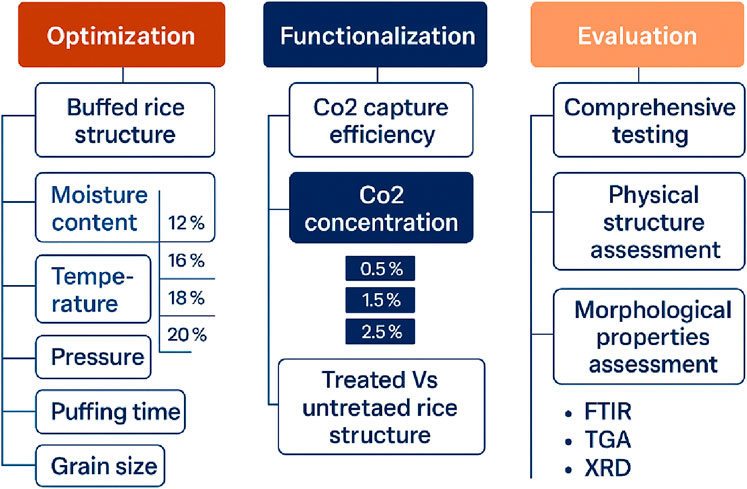
Figure 1. Integrated framework for novel rice-based purification materials: Sequential Analysis and testing process.
3.1 Phase 1: physical activation and structural optimization of puffed rice
The first phase of this study focuses on the structural enhancement of puffed rice to serve as the primary substrate for bio-based air purification applications. The objective of this phase is to optimize the physical characteristics of the rice media—specifically porosity, surface area, and mechanical integrity—to facilitate efficient CO2 adsorption in indoor environments.
Puffed rice, sourced from puffed waste rice, underwent a series of standardized pre-treatment and thermal activation procedures. The process draws upon conventional biomass activation techniques and is adapted to improve the performance of the material under ambient conditions (Koul et al., 2022; Reza et al., 2020; Ahmed et al., 2018).
The activation protocol consisted of the following sequential steps.
• Moisture Reduction: The cleaned rice was air-dried at ambient temperature until moisture content was reduced to below 16%. Maintaining controlled moisture levels was essential to facilitate uniform expansion and effective pore development during heating.
• Thermal Activation: Dried samples were subjected to controlled heating in a buffing chamber at temperatures between 240°C and 280°C. This carbonization step promoted the expansion of rice grains and initiated the formation of micro- and mesopores critical for gas-phase adsorption.
The outcome of Phase 1 established the optimal thermal processing parameters necessary to yield a structurally robust and porous substrate, ensuring high suitability for subsequent hydroxylation treatments aimed at enhancing CO2 adsorption efficiency.
3.2 Phase 2: chemical functionalization with hydroxyl groups for enhanced CO2 capture
The second phase of the methodology involved chemical activation of the puffed rice media to improve its physicochemical properties—specifically pore volume, surface area, and functional group availability—all essential for optimizing gas-phase CO2 adsorption. Alkaline activation was employed due to its well-established capacity to enhance adsorption potential through surface modification (Zhao et al., 2013).
Chemical activation processes are broadly classified as single-stage or dual-stage, depending on whether thermal carbonization precedes the chemical treatment (González-Martín et al., 2021). In this study, a single-stage activation approach was adopted, in which pre-expanded puffed rice samples were directly immersed in aqueous solutions of sodium hydroxide (NaOH). This choice was motivated by the objective of maintaining moderate processing conditions compatible with sustainable, low-energy material fabrication. To establish an alkaline surface environment favorable for CO2 interaction—given its acidic molecular nature—the puffed rice samples were functionalized with hydroxyl groups. Sodium hydroxide solutions of varying molar concentrations (0.25 M–2.5 M) were prepared in 500 mL batches. Circular-shaped samples of puffed rice (8–10 cm diameter; 1.2 cm thickness) were immersed in each solution using a customized immersion apparatus that ensured consistent exposure and saturation (Figure 2).
Following the immersion treatment, the samples were rinsed and air-dried. Both treated and untreated samples were subjected to comparative characterization to quantify the chemical activation’s effectiveness.
• Fourier Transform Infrared Spectroscopy (FTIR): Conducted using an IRTracer-100 spectrometer (Shimadzu, Japan), FTIR analysis was used to identify changes in functional groups post-treatment, particularly the incorporation of hydroxyl (-OH) and carboxyl functionalities.
• Thermogravimetric Analysis (TGA): Using a Q500 analyzer (TA Instruments), thermal degradation patterns and material stability were assessed under a nitrogen atmosphere with a controlled heating rate of 15°C/min.
• X-ray Diffraction (XRD): Structural and crystallinity changes were examined using Cu Kα radiation (λ = 1.54 Å), operated at 30 mA and 40 kV, with a 2θ scan range from 5° to 70°, advancing at 2°/min.
• Scanning Electron Microscopy (SEM): The microstructural evolution of the treated surfaces was examined using SEM imaging at various magnifications to reveal pore structure, surface roughness, and morphological uniformity.
3.3 Phase 3: laboratory evaluation of CO2 capture efficiency
To determine the functional performance of the treated puffed rice media, a series of controlled experiments were conducted using a laboratory-scale CO2 contactor system. This phase aimed to quantify the adsorption capacity of the bio-based material under standardized conditions simulating indoor air quality environments. The testing apparatus consisted of a transparent plexiglass column designed to facilitate vertical gas flow through a packed bed of the adsorbent material as shown in Figure 3.
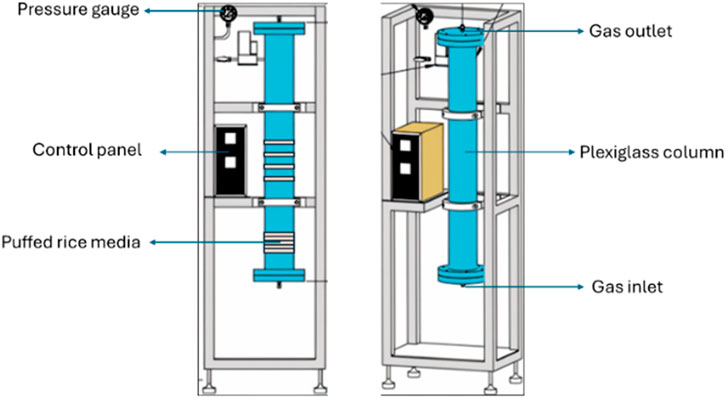
Figure 3. The experimental column setup employed to test the material’s efficiency in capturing CO2.
A pre-mixed gas containing 10% CO2 by volume was introduced at a constant flow rate from a certified pressurized cylinder. The puffed rice medium—either untreated or chemically functionalized with NaOH—was packed into the column to a height of 20 cm, accounting for approximately 20% of the total column volume. Each experimental run lasted 6 h, during which the concentration of CO2 at the column outlet was continuously monitored using a calibrated infrared CO2 gas analyzer. Separate tests were performed for each variant of NaOH-treated samples (0.25 M–2.5 M), along with untreated control samples. The objective was to evaluate the relationship between hydroxylation level and CO2 adsorption capacity.
This phase enabled direct performance comparison across various treatment levels, confirming the effectiveness of chemical functionalization in enhancing the CO2 capture capacity of the puffed rice-based purification medium under realistic environmental conditions.
3.4 Phase 4: comparative analysis with existing activated bio-based materials
To contextualize the performance and applicability of the developed puffed rice-based purification media, a comparative evaluation is undertaken against a range of benchmark activated bio-based materials widely utilized for carbon dioxide (CO2) adsorption in indoor air quality enhancement. This analysis emphasizes a suite of physicochemical and operational metrics, including specific surface area, adsorption capacity, activation conditions, and sustainability considerations.
The critical parameters examined encompass.
• Surface Area (m2/g): A primary determinant of adsorption performance, as higher surface areas facilitate greater pollutant contact and retention.
• CO2 Adsorption Capacity: Typically expressed in mmol/g or as a percentage reduction in CO2 levels, this metric offers a direct indicator of material efficacy.
• Activation Techniques: Both thermal and chemical activation methods impact pore structure and surface functionality, thereby influencing performance.
• Sustainability and Form Factor Adaptability: Parameters such as feedstock renewability, biodegradability, and material geometry determine the practical and environmental feasibility of deployment in building applications.
Table 3 presents a summary of typical performance ranges for these indicators among high-performing bio-based materials.
4 Results and discussion
4.1 Effects of moisture content and temperature on material porosity
This section examines the impact of moisture content and thermal activation on the porosity and puffing efficiency of the treated puffed rice media, a crucial precursor for CO2 adsorption in indoor air purification. Porosity—quantified here by the puffing percentage (i.e., thickness expansion)—directly influences the surface area and the availability of active adsorption sites, which are fundamental for enhancing gas uptake performance.
The experimental matrix consisted of five moisture content levels (12%, 14%, 16%, 18%, and 20%) across four thermal activation conditions (200°C, 220°C, 240°C, and 260°C). Puffing thickness (cm) was recorded as an indicator of porosity development (Figure 4). visualizes the distribution of puffing percentages for different moisture contents and temperatures.
To derive a systematic ranking of optimal conditions, a Multi-Criteria Decision Making (MCDM) approach was employed. The criteria weights were equally distributed across all temperature conditions. Table 4 summarizes the normalized puffing responses and resulting MCDM scores. The moisture content of 18% emerged as the optimal condition, achieving the highest aggregate ranking across all thermal levels.
The results demonstrate a strong interaction between moisture content and thermal treatment in governing the material’s expansion behavior. Moisture levels below 14% yielded suboptimal puffing due to insufficient internal vapor pressure for expansion, while levels above 18% caused structural collapse post-threshold, reducing porosity. At 260°C, the puffing effect was maximized for 18% moisture, reaching 1.2 cm in thickness. This analysis confirms that 18% moisture content at 260°C offers optimal structural porosity, thereby enhancing the material’s theoretical capacity for CO2 adsorption. These findings form the basis for subsequent chemical functionalization and CO2 capture evaluation phases presented in the following sections.
4.2 Sodium hydroxide treatment
Following the physical activation phase, the optimal sample—identified based on its superior puffing percentage, structural integrity, and porosity—was selected for chemical functionalization. This sample exhibited the most favorable characteristics for adsorption applications and was therefore used in all subsequent chemical activation experiments.
To enhance the CO2 adsorption potential of the media, chemical activation was carried out using aqueous NaOH solutions at varying concentrations: 0.25 M, 0.5 M, 1 M, 1.25 M, 2 M, and 2.5 M. Each unit of puffed rice media absorbed approximately 18–22 mL of NaOH solution. After 24 h of air drying under ambient conditions, the treated samples underwent noticeable physical changes: they darkened in color and adopted a pliable, rubber-like texture. These changes indicate successful surface modification and enhanced reactivity. The introduction of hydroxyl functional groups through NaOH treatment promoted both the physisorption and chemisorption of acidic gases such as CO2, thereby improving the material’s overall capture efficiency. The next section details the structural and morphological characterization of the material before and after functionalization to explain the impact of NaOH treatment on its performance attributes.
4.2.1 Structural characterization
These techniques provide information about chemical bonds, crystallinity, thermal behavior, and molecular composition, which reflect the internal structure of the material.
FTIR analysis of untreated and treated samples, shown in Figure 5, identified functional groups. Both samples exhibited peaks for aromatic asymmetric stretching (C=C) at 1,250–1,500 cm−1 and the C=O acetyl group at 1,500–1,700 cm−1, though with reduced intensity in the treated sample. The absorption band at 911–1,011 cm−1 remained unchanged after sodium hydroxide treatment. However, an expanded absorption range was observed at 3,250–3,500 cm−1 in the NaOH-treated sample, indicating increased exposure to hydroxyl groups, which likely enhances its reactivity with CO2 during the absorption/adsorption process.
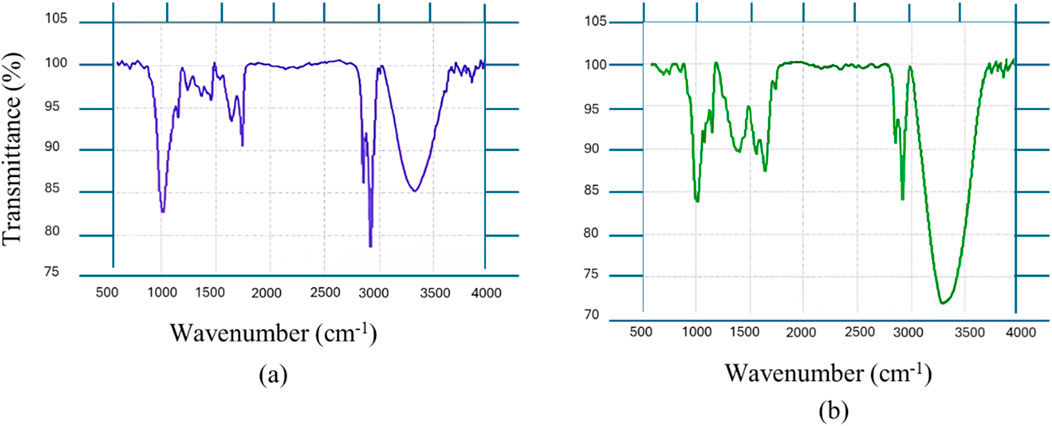
Figure 5. FTIR Spectra Comparison for the puffed rice without treatment (a) and after modification with sodium hydroxide (b).
The TGA analysis on the untreated and treated puffed media using a Q500 analyzer tracked mass loss during thermal decomposition. DTG curves showed faster mass loss in untreated samples beyond 243.5°C (Figure 6a) compared to treated ones (Figure 6b). Between 21°C and 309°C, untreated media lost 2.3% mass, linked to moisture evaporation (Figure 6c), while treated samples showed a smaller 1.6% reduction (Figure 6d), indicating improved thermal stability. The results suggest that sodium hydroxide-treated media has enhanced stability and potential for effective CO2 capture below 200°C.
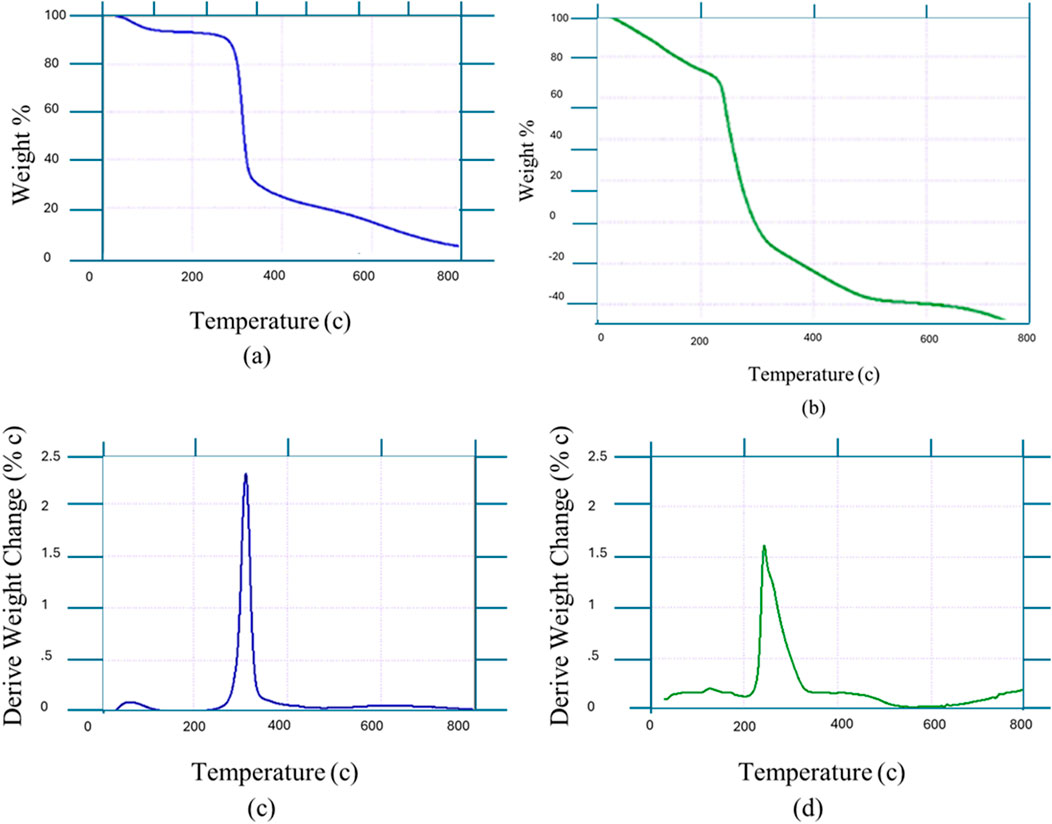
Figure 6. (a) TGA curve of untreated puffed rice media; (b) TGA curve of NaOH-treated puffed rice media; (c) DTG curve of untreated media; (d) DTG curve of NaOH-treated media.
In the XRD test, the untreated sample displayed an A-type diffraction pattern with a peak at 2θ = 20.3°. Sodium hydroxide-treated samples showed a V-type pattern with peaks at 2θ = 17.2° and 20.3°, indicating the formation of hydroxide bonds (Figure 7).
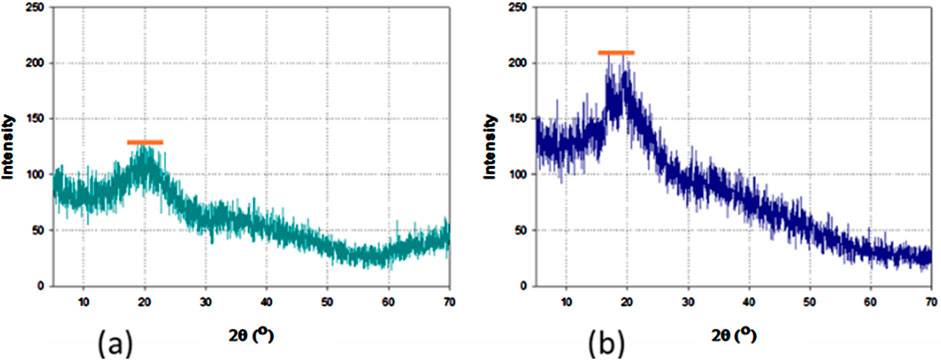
Figure 7. XRD analysis of (a) untreated rice media and (b) rice media modified with sodium hydroxide.
4.2.2 Morphological characterization
The SEM images revealed structural differences between untreated and treated sample cross-sections (Figure 8). Untreated samples showed a porous arrangement with varying cavity sizes, featuring both empty spaces and solid sections. In treated samples, voids and hollow spaces were notably enlarged, enhancing porosity. This increased porosity improves CO2 removal efficiency by refining adsorption and absorption, consistent with previous research suggesting that such modifications can boost gas permeability (Soreanu et al., 2013).
4.3 Effect of NaOH concentration on CO2 adsorption
A series of laboratory-scale evaluations were conducted to assess the CO2 capture performance of NaOH-treated puffed rice media under controlled conditions. The experimental setup comprised vertically layered media samples (8 cm in diameter and 1–1.2 cm in thickness), occupying 20% of the contactor reactor volume. These media layers were exposed to varying NaOH concentrations ranging from 0.5 M to 2.5 M, while a simulated gas stream with an initial CO2 concentration of 10% was continuously passed through the column. Under optimized conditions, the system achieved a maximum CO2 removal of 0.37 moles, reducing the CO2 concentration in the effluent stream to approximately 6.2%.
As illustrated in Figure 9, a pronounced enhancement in CO2 uptake was observed with increasing NaOH concentration, with peak adsorption occurring at 2.0 M. The untreated puffed rice media exhibited a baseline adsorption efficiency of 22.4%. Treatment with 2.0 M NaOH elevated this efficiency to 38.0%, corresponding to an improvement of approximately 84% compared to the untreated control.
This increase in CO2 capture capacity is primarily attributed to the chemical functionalization process, wherein hydroxyl groups introduced by NaOH treatment enhanced the material’s affinity toward acidic CO2 molecules. This mechanism is in line with previous findings that highlight the role of alkaline functional groups in promoting acid-base interactions on bio-adsorbent surfaces. However, a decline in adsorption efficiency was noted at 2.5 M NaOH (0.3 moles), which may be ascribed to over-functionalization effects. Excessive chemical loading can obstruct micropores or induce partial structural collapse, thereby restricting the accessibility of active sites and hindering gas diffusion pathways. Similar effects have been reported in chemically over-activated biochars and carbon-based adsorbents.
4.4 Comparative evaluation of CO2 adsorption performance
To evaluate the practical efficacy of the developed puffed rice-based purification media, a comparative assessment was conducted against selected state-of-the-art bio-based and activated carbon materials widely reported in the literature for CO2 adsorption. This comparison considered not only adsorption capacity, but also activation temperature, processing complexity, sustainability, and potential for architectural integration. Such multi-dimensional benchmarking is essential to ascertain the innovative contribution and applied value of the proposed material.
As summarized in Table 5, materials such as coconut shell activated carbon, bamboo-derived activated carbon, and agricultural biochar represent common standards in the field of low-cost CO2 sorbents. Coconut-shell activated carbon, for instance, achieves a high adsorption range (4.5–6.2 mmol/g) due to its well-developed microporous structure, but requires high-energy thermal activation exceeding 900°C and often relies on chemical activation with KOH, which may introduce corrosivity concerns and post-treatment waste challenges (Yang et al., 2010).
Similarly, bamboo-based biochar activated at temperatures above 800°C offers a moderate adsorption performance (∼4.0 mmol/g), but its granular or powder form limits practical deployment in interior systems without additional binding or encapsulation technologies (Ahmad et al., 2007). Agricultural waste-derived biochars, while sustainable and low-cost, typically exhibit lower CO2 uptake (∼2.5–3.5 mmol/g) unless enhanced through chemical activation, and their morphology often lacks the structural uniformity required for systematic deployment (Shafawi et al., 2021).
In contrast, the proposed puffed rice media activated through a two-step process—thermal expansion at 260°C followed by chemical functionalization with 2.0 M NaOH—demonstrated a CO2 adsorption capacity of approximately 4.6 mmol/g (equivalent to 38% CO2 removal under test conditions and the material mass). This performance is comparable to high-end bio-adsorbents, with the added advantages of lower thermal processing energy, material biodegradability, and ease of geometric adaptation into indoor paneling systems.
The lightweight nature (∼8 g per unit), moldability, and passive operation potential of the treated puffed rice panels suggest their high suitability for integration into indoor air purification strategies—particularly in resource-constrained or retrofit scenarios. Additionally, the material supports modular deployment without reliance on electricity or auxiliary equipment, aligning with current sustainability targets and net-zero emission goals in the built environment sector.
5 Conclusion
This study offers a novel solution to two pressing environmental issues: food waste management and the development of sustainable, eco-friendly construction materials. By repurposing waste rice grains, the research presents an innovative material with significant potential for improving IAQ through CO2 capture.
Experimental findings emphasized the critical role of moisture content and temperature in optimizing the puffing and expansion process of rice. The material achieved maximum thickness and porosity at 18% moisture content and a temperature of 260°C, resulting in an enhanced internal structure essential for CO2 absorption. After treatment with NaOH, the puffed rice media demonstrated improved flexibility and adaptability to various molds and designs, highlighting its suitability for diverse architectural applications.
The NaOH treatment not only improved the structural properties of the material but also significantly increased its CO2 capture efficiency. This enhancement is attributed to the formation of additional hydroxyl groups on the material’s surface, which facilitated CO2 absorption and adsorption mechanisms. These findings were corroborated by various analytical techniques, including FTIR, XRD, SEM, and TGA.
Laboratory-scale tests further validated the practical application of the treated rice media, demonstrating its ability to remove 38% of CO2 from a controlled gas mixture. This substantial reduction in CO2 levels underscores the material’s potential for real-world applications, particularly in passive air purification systems for buildings. Its ability to function without energy-intensive mechanical systems positions it as a promising candidate for improving IAQ in sustainable architecture.
Future research should focus on using advanced simulation tools to model the material’s performance in real-life conditions, such as different room sizes, airflow rates, and CO2 concentrations. These simulations will help refine the material’s design, optimizing parameters like thickness, surface area, and placement within indoor spaces. Additionally, investigating the material’s lifecycle, including durability and recyclability, will be crucial for assessing its overall environmental impact. Long-term performance, especially in high-humidity environments, remains another key area for further exploration to ensure the material’s viability and sustainability over time.
Data availability statement
The raw data supporting the conclusions of this article will be made available by the authors, without undue reservation.
Author contributions
AD: Conceptualization, Data curation, Formal analysis, Methodology, Writing – original draft, Writing – review and editing. MK: Funding acquisition, Project administration, Supervision, Writing – review and editing. AM: Resources, Supervision, Writing – original draft. AA: Resources, Supervision, Writing – original draft. AB-J: Resources, Supervision, Writing – original draft.
Funding
The author(s) declare that financial support was received for the research and/or publication of this article. This work was supported by AUA-UAEU Joint Research (Grant Code: G00004224).
Conflict of interest
The authors declares that the research was conducted in the absence of any commercial or financial relationships that could be construed as a potential conflict of interest.
Generative AI statement
The author(s) declare that no Generative AI was used in the creation of this manuscript.
Publisher’s note
All claims expressed in this article are solely those of the authors and do not necessarily represent those of their affiliated organizations, or those of the publisher, the editors and the reviewers. Any product that may be evaluated in this article, or claim that may be made by its manufacturer, is not guaranteed or endorsed by the publisher.
References
Ahmad, A. L., Loh, M. M., and Aziz, J. A. (2007). Preparation and characterization of activated carbon from bamboo by microwave-induced KOH activation. Carbon 45 (3), 568–575. doi:10.1016/j.carbon.2006.10.029
Ahmed, A., Bakar, M. S. A., Azad, A. K., Sukri, R. S., and Mahlia, T. M. I. (2018). Potential thermochemical conversion of bioenergy from Acacia species in Brunei Darussalam: a review. Renew. Sustain. Energy Rev. 82, 3060–3076. doi:10.1016/j.rser.2017.10.032
Alharthi, M., Hanif, I., and Alamoudi, H. (2022). Impact of environmental pollution on human health and financial status of households in MENA countries: future of using renewable energy to eliminate the environmental pollution. Renew. Energy 190, 338–346. doi:10.1016/j.renene.2022.03.118
Al Horr, Y., Arif, M., Kaushik, A., Mazroei, A., Katafygiotou, M., and Elsarrag, E. (2016). Occupant productivity and office indoor environment quality: a review of the literature. Build. Environ. 105, 369–389. doi:10.1016/j.buildenv.2016.06.001
ASHRAE (2016). Standard 62.1–2016 ventilation for acceptable indoor air quality. Corners, GA: ASHRAE.
Benka-Coker, W., Young, B., Oliver, S., Schaeffer, J. W., Manning, D., Suter, J., et al. (2021). Sociodemographic variations in the association between indoor environmental quality in school buildings and student performance. Build. Environ. 206, 108390. doi:10.1016/j.buildenv.2021.108390
Bluyssen, P. M., Roda, C., Mandin, C., Fossati, S., Carrer, P., de Kluizenaar, Y., et al. (2016). Self-reported health and comfort in ‘modern’ office buildings: first results from the European OFFICAIR study. Indoor Air 26, 298–317. doi:10.1111/ina.12196
Branco, P. T., Sousa, S. I., Dudzińska, M. R., Ruzgar, D. G., Mutlu, M., Panaras, G., et al. (2024). A review of relevant parameters for assessing indoor air quality in educational facilities. Environ. Res. 261, 119713. doi:10.1016/j.envres.2024.119713
Burge, P. S. (2004). Sick building syndrome: Figure 1. Occup. Environ. Med. 61, 185–190. doi:10.1136/oem.2003.008813
Choe, Y., Shin, J.-S, Park, J., Kim, E., Oh, N., Min, K., et al. (2022). Inadequacy of air purifier for indoor air quality improvement in classrooms without external ventilation. Build. Environ. 207, 108450. doi:10.1016/j.buildenv.2021.108450
Danish, M., and Ahmad, T. (2018). A review on utilization of wood biomass as a sustainable precursor for activated carbon production and application. Renew. Sustain. Energy Rev. 87, 1–21. doi:10.1016/j.rser.2018.02.003
Du, L., Batterman, S., Parker, E., Godwin, C., Chin, J. Y., O'Toole, A., et al. (2011). Particle concentrations and effectiveness of free-standing air filters in bedrooms of children with asthma in Detroit, Michigan. Build. Environ. 46 (11), 2303–2313. doi:10.1016/j.buildenv.2011.05.012
Geng, Y., Sarkis, J., and Ulgiati, S. (2019). Circular economy approaches in the construction industry. Resour. Conservation Recycl. 136, 11–21. doi:10.1016/j.resconrec.2018.04.022
González-Martín, J., Kraakman, N. J. R., Pérez, C., Lebrero, R., and Muñoz, R. (2021). A state–of–the-art review on indoor air pollution and strategies for indoor air pollution control. Chemosphere 262, 128376. doi:10.1016/j.chemosphere.2020.128376
Gullón, B., Lú-Chau, T., Moreira, M. T., Lema, J. M., and Eibes, G. (2017). Biofiltration of volatile organic compounds: an effective air purification technology. Appl. Microbiol. Biotechnol. 101 (2), 2763–2777. doi:10.1007/s00253-017-8194-1
Hu, S. C., Shiue, A., Chang, S. M., Chang, Y. T., Tseng, C. H., Mao, C. C., et al. (2016). Removal of carbon dioxide in the indoor environment with sorption-type air filters. Int. J. LowCarbon Tec. 12, 330–334. doi:10.1093/ijlct/ctw014
Karimi, M., Rodrigues, A. E., and Silva, J. A. (2021). Biomass as a source of adsorbents for CO2 capture. In: Advances in bioenergy and microfluidic applications. Amsterdam, Netherlands: Elsevier. p. 255–274.
Khoukhi, M., Abeer, D. S., Ahmed, H., and Abdelbaqi, S. (2021). Thermal characterization of a new bio-based insulation material containing puffed rice. Energies 14 (18), 5700. doi:10.3390/en14185700
Khoukhi, M., Dar Saleh, A., Mohammad, A. F., Hassan, A., and Abdelbaqi, S. (2022). Thermal performance and statistical analysis of a new bio-based insulation material produced using grain puffing technique. Constr. Build. Mater. 345, 128311. doi:10.1016/j.conbuildmat.2022.128311
Kotol, M., Rode, C., Clausen, G., and Nielsen, T. R. (2014). Indoor environment in bedrooms in 79 Greenlandic households. Build. Environ. 81, 29–36. doi:10.1016/j.buildenv.2014.05.016
Koul, B., Yakoob, M., and Shah, M. P. (2022). Agricultural waste management strategies for environmental sustainability. Environ. Res. 206, 112285. doi:10.1016/j.envres.2021.112285
Kuo, L. (2013). Wasted rice in asia emits over 600 million tonnes of greenhouse gases a year. New York, NY: QUARTZ. Available online at: https://qz.com/123456/wasted-rice-in-asia-emits-over-600-million-tonnes-of-greenhouse-gases-a-year/(Accessed July 8, 2024).
Levin, H. (2003). Indoor air pollutants. Part 1: general description of pollutants, levels and standards. Vent. Inf. Pap. 2, 12.
Li, S., Yuan, X., Deng, S., Zhao, L., and Lee, K. B. (2021). A review on biomass-derived CO2 adsorption capture: adsorbent, adsorber, adsorption, and advice. Renew. Sustain. Energy Rev. 152, 111708. doi:10.1016/j.rser.2021.111708
López, L. R., Dessì, P., Cabrera-Codony, A., Rocha-Melogno, L., Kraakman, B., Naddeo, V., et al. (2023). CO2 in indoor environments: from environmental and health risk to potential renewable carbon source. Sci. Total Environ. 856, 159088. doi:10.1016/j.scitotenv.2022.159088
Makepa, D. C., and Chihobo, C. H. (2024). Sustainable pathways for biomass production and utilization in carbon capture and storage—a review. Biomass Convers. Biorefinery 15, 11397–11419. doi:10.1007/s13399-024-06010-5
Mewomo, M. C., Toyin, J. O., Iyiola, C. O., and Aluko, O. R. (2023). Synthesis of critical factors influencing indoor environmental quality and their impacts on building occupant’s health and productivity. J. Eng. Des. Technol. 21 (2), 619–634. doi:10.1108/jedt-10-2021-0595
Mohammad, A. F., Dar Saleh, A. F., Khoukhi, M., and Ali, H. A.-M. (2022). A New method for capturing CO2 from effluent gases using a rice-based product. Energies 15 (6), 2287. doi:10.3390/en15062287
Nanda, S., Dalai, A. K., and Kozinski, J. A. (2016). Biocarbon production from biomass: advances in green air purification materials. Environ. Chem. Lett. 14 (2), 195–207. doi:10.1007/s10311-016-0551-0
Pal, R., Patidar, A., and Jain, R. (2020). Bio-based air purification systems: role in improving indoor air quality. J. Environ. Sci. Technol. 14 (4), 451–461. doi:10.3923/jest.2020.451.461
Pang, L., Zhang, J., Cao, X., Wang, X., Liang, J., Zhang, L., et al. (2021). The effects of carbon dioxide exposure concentrations on human vigilance and sentiment in an enclosed workplace environment. Indoor air 31 (2), 467–479. doi:10.1111/ina.12746
Persily, A. (2015). Challenges in developing ventilation and indoor air quality standards: the story of ASHRAE Standard 62. Build. Environ. 91, 61–69. doi:10.1016/j.buildenv.2015.02.026
Quan, C., Zhou, Y., Wang, J., Wu, C., and Gao, N. (2023). Biomass-based carbon materials for CO2 capture: a review. J. CO2 Util. 68, 102373. doi:10.1016/j.jcou.2022.102373
Reza, M. S., Yun, C. S., Afroze, S., Radenahmad, N., Bakar, M. S. A., Saidur, R., et al. (2020). Preparation of activated carbon from biomass and its’ applications in water and gas purification, a review. Arab J. Basic Appl. Sci. 27 (1), 208–238. doi:10.1080/25765299.2020.1766799
Rosário Filho, N. A., Urrutia-Pereira, M., d'Amato, G., Cecchi, L., Ansotegui, I. J., Galán, C., et al. (2021). Air pollution and indoor settings. World Allergy Organ. J. 14 (1), 100499. doi:10.1016/j.waojou.2020.100499
Satish, U., Mendell, M. J., Shekhar, K., Hotchi, T., Sullivan, D., Streufert, S., et al. (2012). Is CO2 an indoor pollutant? Direct effects of low-to-moderate CO2 concentrations on human decision-making performance. Environ. Health Perspect. 120, 1671–1677. doi:10.1289/ehp.1104789
Schripp, T., Salge, S., and Salthammer, T. (2017). Bio-based air purification materials: reducing indoor VOC levels through sustainable solutions. Atmos. Environ. 168, 78–84. doi:10.1016/j.atmosenv.2017.08.059
Shafawi, A. N., Mohamed, A. R., Lahijani, P., and Mohammadi, M. (2021). Recent advances in developing engineered biochar for CO2 capture: an insight into the biochar modification approaches. J. Environ. Chem. Eng. 9 (6), 106869. doi:10.1016/j.jece.2021.106869
Soreanu, G., Dixon, M., and Darlington, A. (2013). Plant-based air purification systems: engineering biotechnologies for indoor air quality improvement. Biotechnol. Adv. 31 (2), 136–142. doi:10.1016/j.biotechadv.2012.09.005
Tang, H., Pan, Z., and Li, C. (2022). Tempo-spatial infection risk assessment of airborne virus via CO2 concentration field monitoring in built environment. Build. Environ. 217, 109067. doi:10.1016/j.buildenv.2022.109067
Vilčeková, S., Apostoloski, I. Z., Mečiarová, L’., Burdová, E. K., and Kisel’ák, J. (2017). Investigation of indoor air quality in houses of Macedonia. Int. J. Environ. Res. Public Health 14, 37. doi:10.3390/ijerph14010037
Vouriot, C. V., Burridge, H. C., Noakes, C. J., and Linden, P. F. (2021). Seasonal variation in airborne infection risk in schools due to changes in ventilation inferred from monitored carbon dioxide. Indoor air 31 (4), 1154–1163. doi:10.1111/ina.12818
Wang, W. J., Liu, F. L., Zhang, Q. X., Yu, G., and Deng, S. (2020b). Efficient removal of CO2 from indoor air using a polyethyleneimine-impregnated resin and its low-temperature regeneration. Chem. Eng. J. 399, 125734. doi:10.1016/j.cej.2020.125734
Wang, Z., Zhang, J. S., and Wei, W. (2014). Performance of biofiltration for removing volatile organic compounds in indoor air. J. Hazard. Mater. 278, 437–444. doi:10.1016/j.jhazmat.2014.06.021
World Health Organization (2021). WHO global air quality guidelines: particulate matter (PM2.5 and PM10), ozone, nitrogen dioxide, sulfur dioxide and carbon monoxide. Geneva, Switzerland: World Health Organization.
Yang, K., Peng, J., Srinivasakannan, C., Zhang, L., Xia, H., and Duan, X. (2010). Preparation of high surface area activated carbon from coconut shells using microwave heating. Bioresour. Technol. 101 (15), 6163–6169. doi:10.1016/j.biortech.2010.03.001
Yang, L., Zhang, J., Yang, Y., Wang, N., Zhang, Z., and Chen, L. (2024). Effects of high carbon dioxide concentration on emotional processing: based on multimodal evidence. Build. Environ. 256, 111434. doi:10.1016/j.buildenv.2024.111434
Yang, W., Lee, K., and Chung, M. (2004). Characterization of indoor air quality using multiple measurements of nitrogen dioxide. Indoor Air 14, 105–111. doi:10.1046/j.1600-0668.2003.00216.x
Yue, X., Ma, N. L., Sonne, C., Guan, R., Lam, S. S., Van Le, Q., et al. (2021). Mitigation of indoor air pollution: a review of recent advances in adsorption materials and catalytic oxidation. J. Hazard. Mater. 405, 124138. doi:10.1016/j.jhazmat.2020.124138
Keywords: bio-based purification material, carbon capture, environmental sustainability, indoor pollutants, energy saving
Citation: Dar Saleh A, Khoukhi M, Mohammad A, Al Marzouqi A and Bessadok-Jemai A (2025) Sustainable indoor air purification using treated puffed rice waste: a functional and structural material evaluation. Front. Built Environ. 11:1626770. doi: 10.3389/fbuil.2025.1626770
Received: 13 May 2025; Accepted: 07 July 2025;
Published: 14 August 2025.
Edited by:
Hazim Bashir Awbi, University of Reading, United KingdomReviewed by:
Marwa Fahmy, Helwan University, EgyptNicola Pisacane, University of Campania Luigi Vanvitelli, Italy
Copyright © 2025 Dar Saleh, Khoukhi, Mohammad, Al Marzouqi and Bessadok-Jemai. This is an open-access article distributed under the terms of the Creative Commons Attribution License (CC BY). The use, distribution or reproduction in other forums is permitted, provided the original author(s) and the copyright owner(s) are credited and that the original publication in this journal is cited, in accordance with accepted academic practice. No use, distribution or reproduction is permitted which does not comply with these terms.
*Correspondence: Maatouk Khoukhi, bWtob3VraGlAdWFldS5hYy5hZQ==
 Abeer Dar Saleh
Abeer Dar Saleh Maatouk Khoukhi
Maatouk Khoukhi Ameera Mohammad1
Ameera Mohammad1
